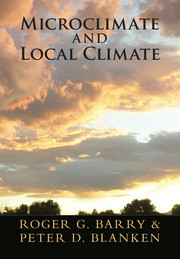Book contents
- Frontmatter
- Contents
- Preface
- Acknowledgments
- 1 Introduction
- Part I Controls of Microclimate
- 2 Microclimatic Elements
- 3 Methods of Observation and Instrumentation
- 4 Radiation
- 5 The Energy Balance
- 6 Monitoring Radiation, Energy, and Moisture Balance via Remote Sensing and Modeling with Land Surface Models
- 7 Microclimates of Different Vegetated Environments
- 8 Microclimates of Physical Systems
- 9 Bioclimatology
- Part II Local (Topo-)Climates
- Part III Environmental Change
- Problems
- Glossary
- Symbols
- System International (SI) Units and Conversions
- Index
- References
3 - Methods of Observation and Instrumentation
from Part I - Controls of Microclimate
Published online by Cambridge University Press: 05 May 2016
- Frontmatter
- Contents
- Preface
- Acknowledgments
- 1 Introduction
- Part I Controls of Microclimate
- 2 Microclimatic Elements
- 3 Methods of Observation and Instrumentation
- 4 Radiation
- 5 The Energy Balance
- 6 Monitoring Radiation, Energy, and Moisture Balance via Remote Sensing and Modeling with Land Surface Models
- 7 Microclimates of Different Vegetated Environments
- 8 Microclimates of Physical Systems
- 9 Bioclimatology
- Part II Local (Topo-)Climates
- Part III Environmental Change
- Problems
- Glossary
- Symbols
- System International (SI) Units and Conversions
- Index
- References
Summary
Introduction
The task of observing the microclimate of a region or object in a quantitative manner is important to the discipline for many reasons. As a consequence, many of the innovations and developments in meteorological instrumentation stem from the microclimate community. Initially (and currently), the agricultural community had a great interest in measuring the key variables that were (are) important for crop growth and yields: solar radiation (photosynthetic active radiation, or PAR), air and soil temperature, precipitation, and soil properties (texture for proper drainage and water retention, water content). As such, instruments and techniques for measuring the spatial and temporal variability of these and other crop variables were developed within agriculture and soil physics departments at many universities. Given the need to understand the spatial aspects of microclimate, such as the spatial interpolation between measurement locations, geography departments also often fostered and refined microclimate observations and instrumentation.
This chapter provides a review of some of the main techniques, instrumentation, and theory behind micrometeorological observations. The fundamental principles governing these observations are first discussed. This is followed by discussions of the measurement of temperature, soil properties (temperature, moisture, and heat flux), radiation, wind, precipitation, total and partial atmospheric pressures, and turbulent fluxes.
Fundamentals
Any measurement strives to quantify reality. The measurement's accuracy refers to the difference between reality and what the instrument actually detects. For example, if the actual air temperature is 25 °C, a thermometer reading 24 °C is more accurate than one reading 28 °C. In addition to accuracy, a well-designed instrument should have a high precision, meaning that the instrument should read the same value if the conditions are not changing. For example, an object is at a steady temperature of 10 °C. A thermometer that reads 10 °C for five consecutive measurements would be said to have a high precision and high accuracy. If the thermometer “drifted” so that the five consecutive readings were, 10, 9, 8, 7, 6 °C, respectively, the thermometer would have a low precision and low accuracy. Note that an instrument could be precise, but not accurate (see Figure 3.1). In the previous example, consecutive readings of 4 °C while the actual temperature is 10 °C would indicate a high-precision, but low accuracy, thermometer. Ideally an instrument should be accurate and precise.
Information
- Type
- Chapter
- Information
- Microclimate and Local Climate , pp. 52 - 80Publisher: Cambridge University PressPrint publication year: 2016
